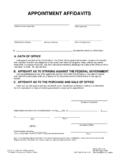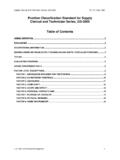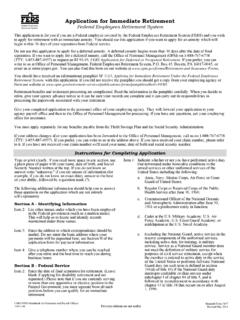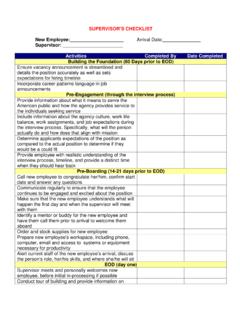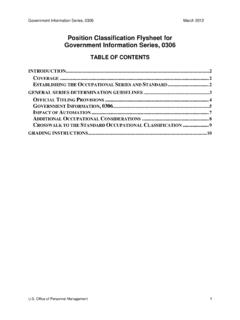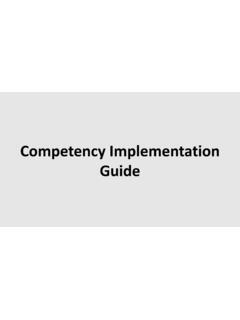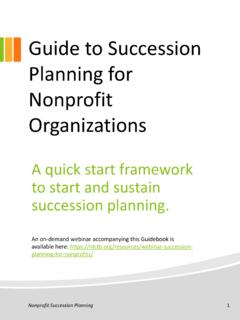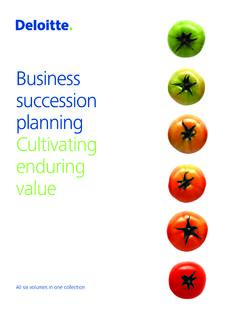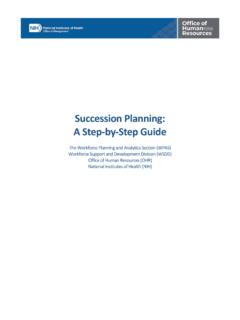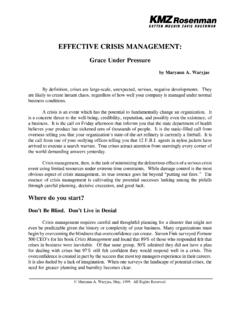Transcription of End to End Hiring Initiative - OPM.gov
1 MARCH 2017 End to End Hiring InitiativeUnited StateS Office Of PerSOnnel ManageMent 1 TABLE OF CONTENTS PREAMBLE 3 CHAPTER 1 Background 4 CHAPTER 2 Methodology 7 CHAPTER 3 The End-to-End (E2E)
2 Hiring Roadmap 10 o The E2E Roadmap Comprehensive set of integrated components o Workforce planning 11-17 Overview Assumptions Challenges Elements and Tasks Measures o Recruitment 18-26 Overview Assumptions Challenges Elements and Tasks Measures o Hiring 27-37 Overview Assumptions Challenges Elements and Tasks Measures o Security and Suitability 38-43 Overview Assumptions Challenges Elements and Tasks Measures o Orientation 44-52 Overview Assumptions Challenges Elements and Tasks Measures o Measures 53 2 Appendix A References 54 Appendix B Participants 56 Appendix C - Way Ahead (Timeline and Milestones) 57 3 Preamble The End-to-End (E2E)
3 Hiring Roadmap is a product of the partnership between the Office of Personnel Management and the Chief Human Capital Officers Council Subcommittee for Hiring and succession planning . This new approach to Federal Hiring is designed to focus on the applicant: his or her expectations, needs and interests. One of the challenges facing Federal agencies is how to attract and recruit qualified individuals by meeting their expectations for user-friendly application procedures, clear communication about the Hiring process and an engaging orientation experience. The E2E Hiring Roadmap puts into practice the principles underlying the following Pledge to Applicants. Pledge to Applicants* We recognize that a Government s most important asset is its people.
4 To attract talented people to the service of the Nation, we believe the application process should enable rather than deter job seekers. To that end, we will work to ensure a process that reflects these principles. 1. A user-friendly application process that is not unduly burdensome or time consuming. 2. Clear, understandable job announcements and instructions for applying. 3. Timely and informed responses to questions about the requirements and the process. 4. Prompt acknowledgement that their application has been received. 5. Regular updates on the status of their applications as significant decisions are reached. 6. A timely decision-making process. * The Pledge to Applicants can be found on the first page of the Delegated Examining Operations Handbook, the principle guide for HR specialists.
5 It can be found at 4 CHAPTER 1 BACKGROUND In the next five years, the Federal Government will lose a significant portion of its valued workforce through attrition, primarily due to retirement. The Government s ability to replace this loss of skills and experience with new talent will depend on our capability to efficiently and effectively recruit, hire and retain high performing employees. There is broad agreement that the current competitive Hiring process could be improved. Applicants regularly report confusion about differences among agencies application processes, complex application requirements that are difficult to meet, and lack of communications from the agencies as to the Hiring process and the applicant s status.
6 Human Resources (HR) professionals express frustration at a perceived lack of managerial commitment to participate fully in the key elements of Hiring such as workforce planning and delays in decision making that slows the process. Managers complain that HR policies and procedures are unclear, overly bureaucratic and non-responsive to their needs. These combined frustrations make it more difficult for the Federal Government to hire qualified employees in the stiff competition for the top talent. Past attempts to address Hiring processes have taken a component-by-component (or stovepiped) approach. Based on these previous experiences and agencies current Hiring needs, OPM decided to take a new, comprehensive and integrated approach to Federal Hiring .
7 In 2008, OPM launched four initiatives, all designed to honor the Pledge to Applicants by transforming the Hiring experience for applicants, managers and HR. These initiatives are: Streamlined job opportunity announcement: In early April, OPM created a new job announcement template for Governmentwide entry-level accounting and secretarial vacancies. Since April, OPM has collaborated with the Federal Acquisition Institute, along with the Chief Information Officer Council, and Patent and Trade Office, and the Chief Financial Officer Council (to name a few) in developing additional streamlined job announcements for the acquisition, information technology, patent and trademark, and law enforcement communities.
8 The new templates reduce the length and complexity of traditional announcements OPM s model is now approximately four pages written in plain language and eliminates the additional requirement, beyond the resume, for further explaining the applicants knowledge, skills and abilities (KSAs). Centralized repository of qualified applicants for the acquisition community: OPM brokered an agreement across major agencies and organizations involved in recruitment for the Governmentwide mission critical occupations (for example: Contract Specialist). The agreement creates a centralized repository of qualified applicants for entry-level acquisition positions. Participating agencies will be able to draw from this central repository for immediate placement of individuals who have already been certified as qualified for these positions.
9 Currently, participants include DOD, the Federal Acquisition Institute (FAI) OPM and others. Senior Executive Service (SES) Pilot: OPM initiated a two-pronged approach to Hiring at the Government s highest levels: one approach provides for ascertaining that the 5applicant possesses Executive Core Qualifications (ECQs) based solely upon his or her resume and the other approach stays more in line with traditional Hiring by requiring the applicant to demonstrate possession of ECQs in a more narrative form. This new practice, which has been implemented as a pilot, will allow OPM to determine whether more streamlined job announcements for its executive leadership will result. End-to-End (E2E) Hiring Initiative : OPM joined with the Chief Human Capital Officers Council Subcommittee for Hiring and succession planning to transform Federal Hiring by strategically integrating and reengineering its five components: workforce planning , recruitment, Hiring process, security and suitability and orientation.
10 This document presents the E2E Hiring Roadmap. The Roadmap explains each of the five components of Hiring , shows how the five are strategically integrated, provides step-by-step implementation instructions and establishes key Governmentwide measures for effective Hiring . The Roadmap is designed to transform the competitive Hiring process for applicants from outside the Federal Government while still complying with applicable law. The E2E Roadmap begins with Workforce planning . Workforce planning is a systematic process for identifying the human resources required to meet an agency s mission and goals and developing strategies to meet these requirements. This includes: 1) determining the number as well as the skills (and proficiency level) of required workers and where and when they will be required; 2) identifying actions that must be taken to attract, develop and retain the number and types of workers the agency requires.

